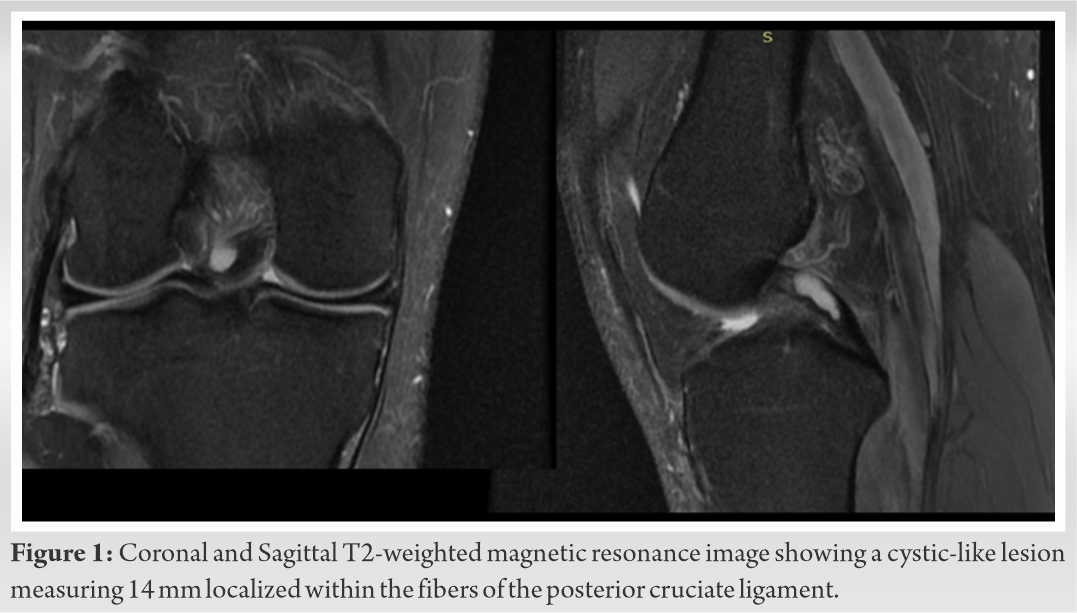Magnetic resonance imaging of the knee remain the gold stand diagnostic tools for patients with unexplained knee pain and non-informative physical examination.
Dr. Mohammad O Boushnak, Department of Orthopedic Surgery, Lebanses Military Hospital, Beirut, Lebanon. E-mail: mohammadboushnak@hotmail.com
Introduction:Ganglion cyst of the cruciate ligaments is a rare entity. These cysts are usually found as incidental finding during knee arthroscopy, even though they can be the cause of knee discomfort or dull pain without a clear etiology.
Case Presentation:We present herein a case of 35-year-old male who presented with unexplained dull knee pain. Magnetic resonance imaging (MRI) was performed and it showed a cystic-like lesion measuring 14 mm localized within the fibers of the posterior cruciate ligament (PCL) with no other significant pathology identified. A diagnosis of symptomatic PCL intrasubstance cyst was made. Patients were treated by arthroscopic debridement with good long-term outcomes.
Conclusion: Ganglion cysts of the PCL are uncommon and especially if they were localized within the PCL fibers. MRI studies are inevitable to make the diagnosis, and arthroscopic debridement remains a reasonable surgical option with low recurrence rate.
Keywords:Sports, knee pain, posterior cruciate ligament cyst, cruciate ligament cyst.
As it is well known that ganglion cysts of the cruciate ligaments are rare entities, where it was first described by Caan in the year 1924. Most of the intra-articular cysts affect the anterior cruciate ligament rather than the posterior cruciate ligament (PCL) [1]. This pathology is frequently found as an incidental finding on imaging or when arthroscopically inspecting the knee [2, 3]. Krudwig reported 85 cases of intra-articular ganglions on a series of 8,000 patients, where 49 involved the ACL and 16 involved the PCL. Herein, we present a case of intra-articular ganglion cyst localized in the mid-substance of the PCL.
A 35-year-old male soldier presented with dull pain in his right knee that had been present for the last several months without any traumatic events. He recalls that the pain is exacerbated with deep knee flexion, sport activities, and long walks. On inspection, no swelling or discoloration were noticed. On physical examination, the knee had no limitation of either active or passive range of motion, was stable without ligamentous laxity, no joint line tenderness, negative signs, and symptoms of patella-femoral pathology. Radiographs of the right knee were insignificant, and further, imaging studies were decided. Magnetic resonance imaging (MRI) was performed and it showed a cystic-like lesion measuring 14 mm localized within the fibers of the PCL with no other significant pathology identified (Fig. 1). After discussing with the patient, the various modalities of treatment, knee arthroscopy for addressing the PCL cyst, and for exploring the knee for associated pathologies were decided. Careful inspection of all knee compartments was done during arthroscopy and no associated lesions were identified. The PCL was split along its fibers at the level of the cyst with a meniscal blade, it was completely evacuated and after that the shaver was introduced in the site of the cyst, where the PCL was debrided completely to lower the recurrence rate but taking into consideration not to harm and damage the PCL which might lead to instability. Histologic studies acquired by basket forceps confirmed the pathology of ganglion cyst. Two weeks postoperatively, the patient was pain free even with position that usually caused exacerbation of symptoms. No recurrence and the patient remained symptom free after 12 months of follow-up.
Ganglions are cystic lesions containing clear and jelly like fluid, it arises from tendon sheaths, joints, menisci, and capsules [4, 5]. Regions of high mechanical stress are most susceptible to ganglions [6, 7], and that is why ganglions are quite common in the knee joint with baker’s cyst being the most frequent [8]. Cruciate ligaments intra-articular cysts are rare, where 0.2–1.3% are diagnosed on knee MRI and 0.6% by knee arthroscopy [2, 3]. On a series of 6,500 knee arthroscopies Brown and Dandy reported 35 ganglions occurring on the cruciate ligaments with 6 of them arising from the PCL [8]. In fact, intra-articular ganglions can affect all ages and both sexes, but it has a male predominance, especially in the age group ranging between 20 and 40 years [6, 9]. Several theories have been advocated in terms of pathogenesis of intra-articular ganglion cysts with mucoid degeneration of connective tissue being the most acceptable [3, 4]. Traumatic nature, herniation of synovial tissue in the course of embryogenesis, and proliferating mesenchymal cells are all held theories causing intra-articular ganglions and recently cyst formation was attributed to trauma and tissue irritation [3, 4]. As by Seki et al., mechanical stress applied on the PCL during knee motion which was a causative etiology of ganglion cyst [10]. PCL ganglions are either anterior or posterior to PCL with prevalence of 87.5% and 12.5%, respectively [11], with no papers in the literature describing a ganglion cyst within the fibers of the PCL as in our case. Various clinical manifestations are associated with PCL cystic formation, but most of them are non-specific [10]. Knee pain is almost always present when the cyst becomes large enough to become symptomatic, in addition to limited range of motion or knee locking in extension or flexion [9, 10]. It can also present with signs and symptoms that mimics meniscal pathology such as clicking sensation and joint line tenderness and positive meniscal provocative tests such as McMurrey test and patients may also present with exacerbating symptoms during sport and functional activities [10]. The diagnosis is most of the times incidental, where the cyst will appear on MRI or ultrasound or during knee arthroscopy [1, 10, 12]. MRI is the modality of choice for diagnosing intra-articular ganglion cysts since it is both sensitive and specific to exactly describe cystic lesions, their size, and location [1]. Ganglion cysts will appear hyperintense on T2 signals and intermediate to hypointense on T1 signals [1]. Multiple approaches have been validated for the treatment of PCL ganglion cysts with arthroscopic resection being the most popular and most preferred by surgeons [11, 13]. In addition to its ease, arthroscopic resection allows the surgeon to carefully inspect and address all the knee compartments for associated injuries and enables complete resection with low recurrence rate when compared to CT guided and ultrasound guided aspirations [3, 11].
Ganglion cysts of the PCL are uncommon and especially if they were localized within the PCL fibers. Its symptomatology ranges from asymptomatic to severe pain with knee flexion mimicking meniscal and intra-articular pathologies. The gold standard for diagnosis is MRI, but it is diagnosed most of the times incidentally. Arthroscopic debridement of the ganglion cyst is associated with lower rate of recurrence than other treatment modalities.
Arthroscopic debridement of PCL intrasubstance cyst remains a reasonable surgical option with low recurrence rate in patient with refractory symptoms.
References
- 1.Krudwig WK, Schulte KK, Heinemann C. Intra-articular ganglion cysts of the knee joint: A report of 85 cases and review of the literature. Knee Surg Sports Traumatol Arthrosc 2004;12:123-9. [Google Scholar]
- 2.Kim MG, Kim BH, Choi JA, Lee NJ, Chung KB, Choi YS, et al. Intra-articular ganglion cysts of the knee: Clinical and MR imaging features. Eur Radiol 2001;11:834-40. [Google Scholar]
- 3.Kim RS, Kim KT, Lee JY, Lee KY. Ganglion cysts of the posterior cruciate ligament. Arthroscopy 2003;19:E36-40. [Google Scholar]
- 4.Zantop T, Rusch A, Hassenpflug J, Petersen W. Intra-articular ganglion cysts of the cruciate ligaments: Case report and review of the literature. Arch Orthop Trauma Surg 2003;123:195-8. [Google Scholar]
- 5.Deutsch A, Veltri DM, Altchek DW, Potter HG, Warren RF, Wickiewicz TL. Symptomatic intraarticular ganglia of the cruciate ligaments of the knee. Arthroscopy 1994;10:219-23. [Google Scholar]
- 6.García-Alvarez F, García-Pequerul JM, Avila JL, Sainz JM, Castiella T. Ganglion cysts associated with cruciate ligaments of the knee: A possible cause of recurrent knee pain. Acta Orthop Belg 2000;66:490-4. [Google Scholar]
- 7.Garcia A, Hodler J, Vaughn L, Haghighi P, Resnick D. Case report 677. Skeletal Radiol 1991;20:373-5. [Google Scholar]
- 8.Brown MF, Dandy DJ. Intra-articular ganglia in the knee. Arthroscopy 1990;6:322-3. [Google Scholar]
- 9.Shetty GM, Nha KW, Patil SP, Chae DJ, Kang KH, Yoon JR, et al. Ganglion cysts of the posterior cruciate ligament. Knee 2008;15:325-9. [Google Scholar]
- 10.Seki K, Mine T, Tanaka H, Isida Y, Taguchi T. Locked knee caused by intraarticular ganglion. Knee Surg Sports Traumatol Arthrosc 2006;14:859-61. [Google Scholar]
- 11.DeFriend DE, Schranz PJ, Silver DA. Ultrasound-guided aspiration of posterior cruciate ligament ganglion cysts. Skeletal Radiol 2001;30:411-4. [Google Scholar]
- 12.Friedman L, Finlay K, Jurriaans E. Ultrasound of the knee. Skeletal Radiol 2001;30:361-77. [Google Scholar]
- 13.Noda M, Kurosaka M, Maeno K, Mizuno K. Case report ganglion cysts of the bilateral cruciate ligaments. Arthroscopy 1999;15:867-70. [Google Scholar]











